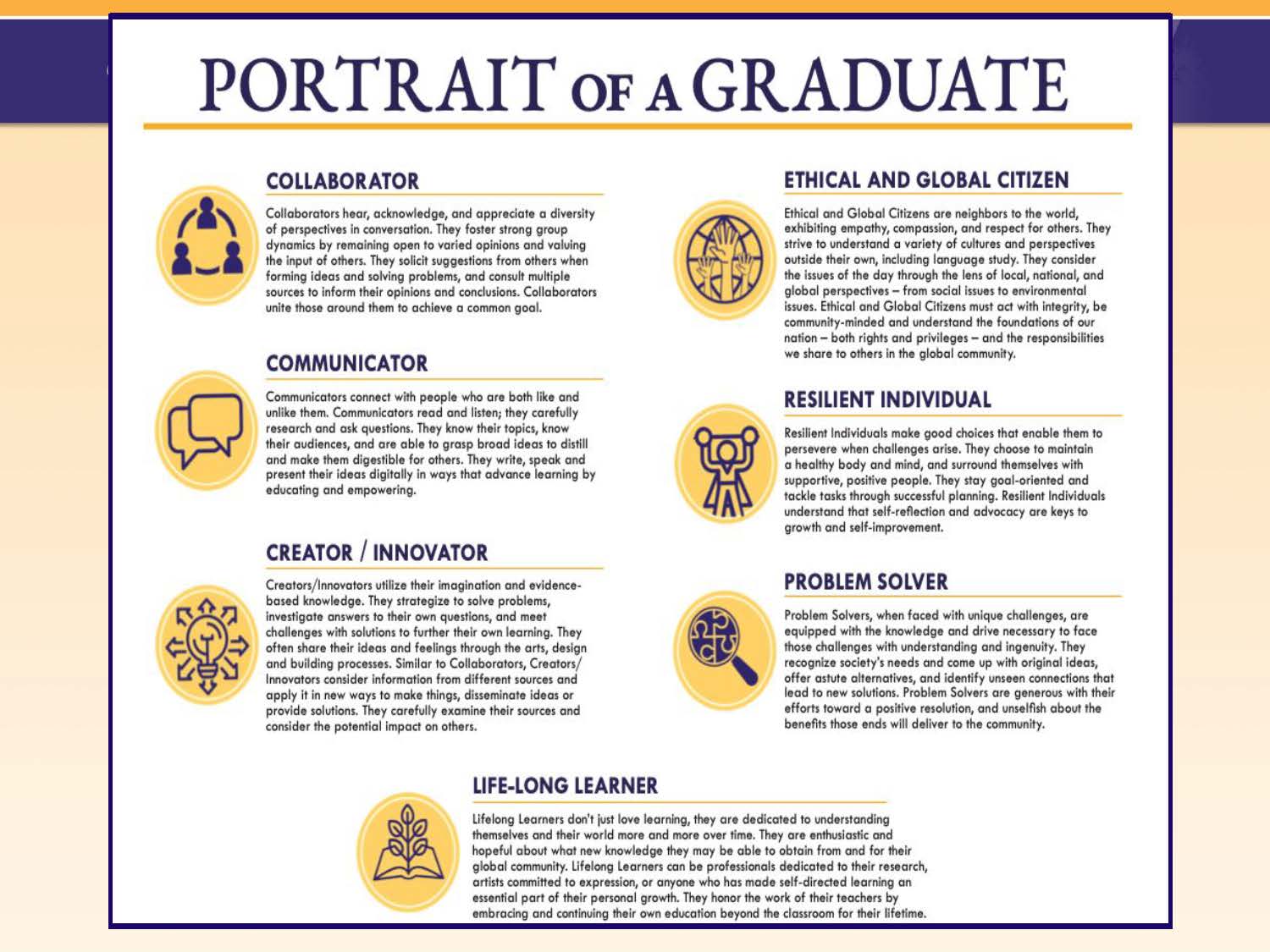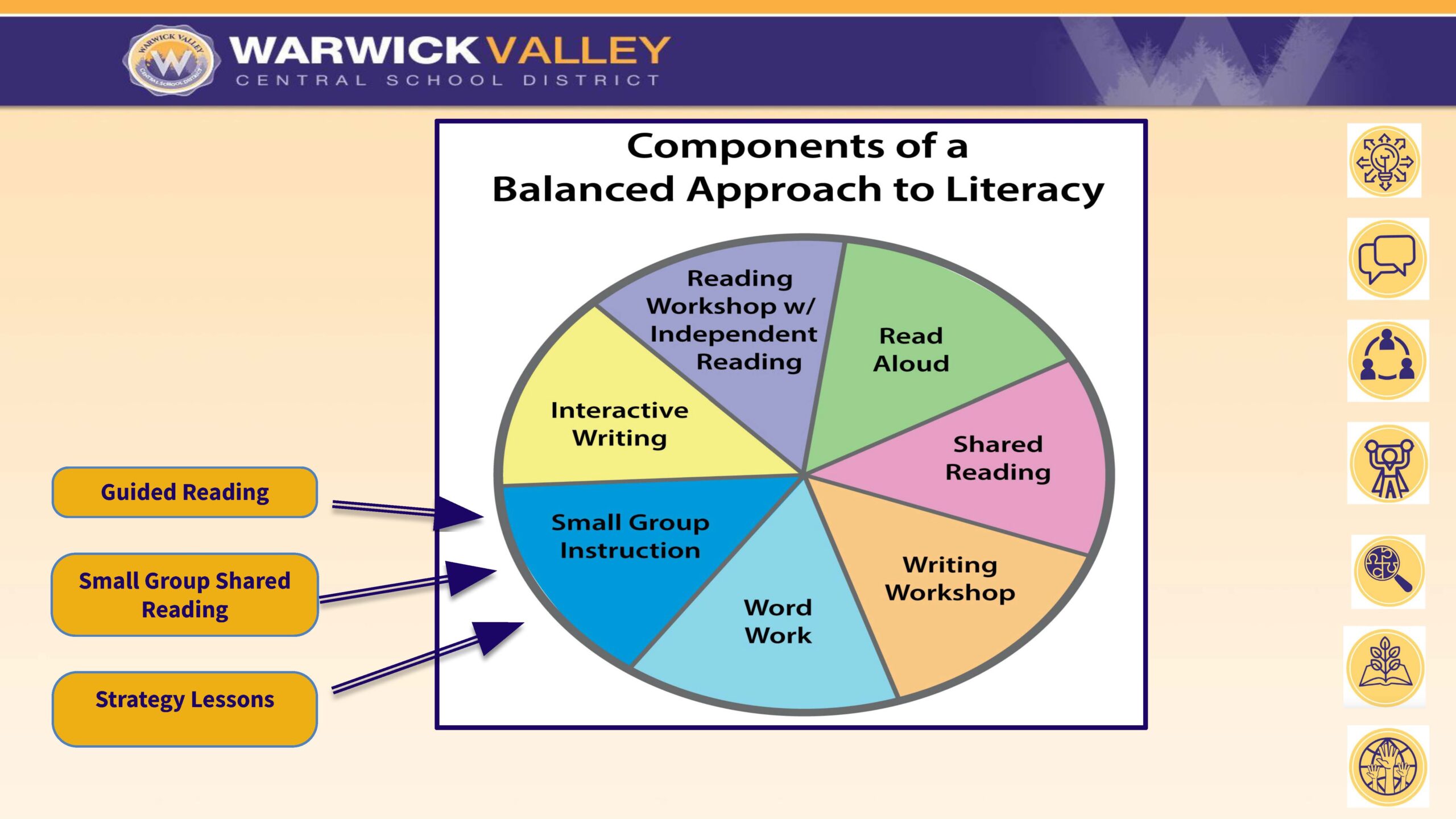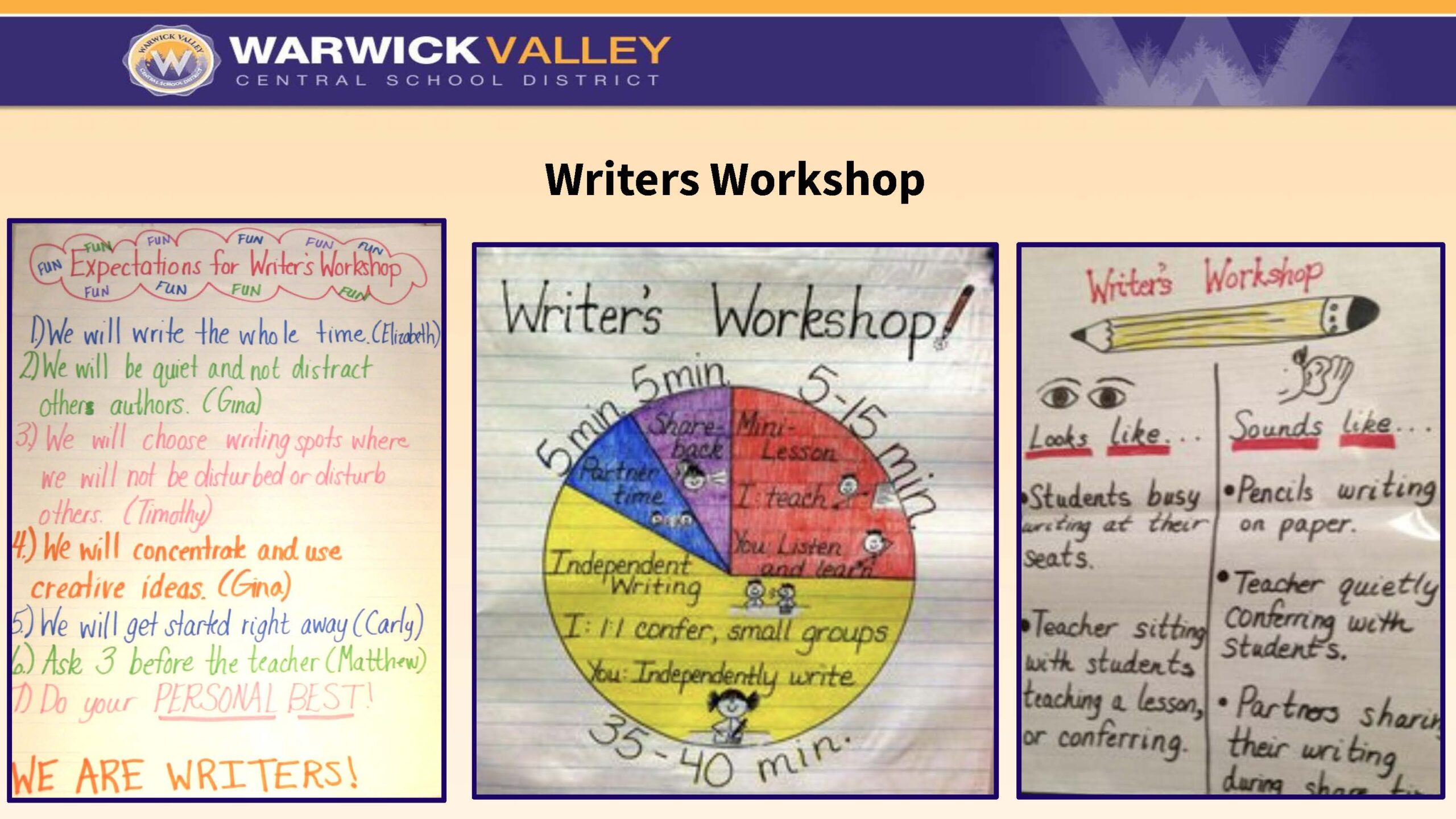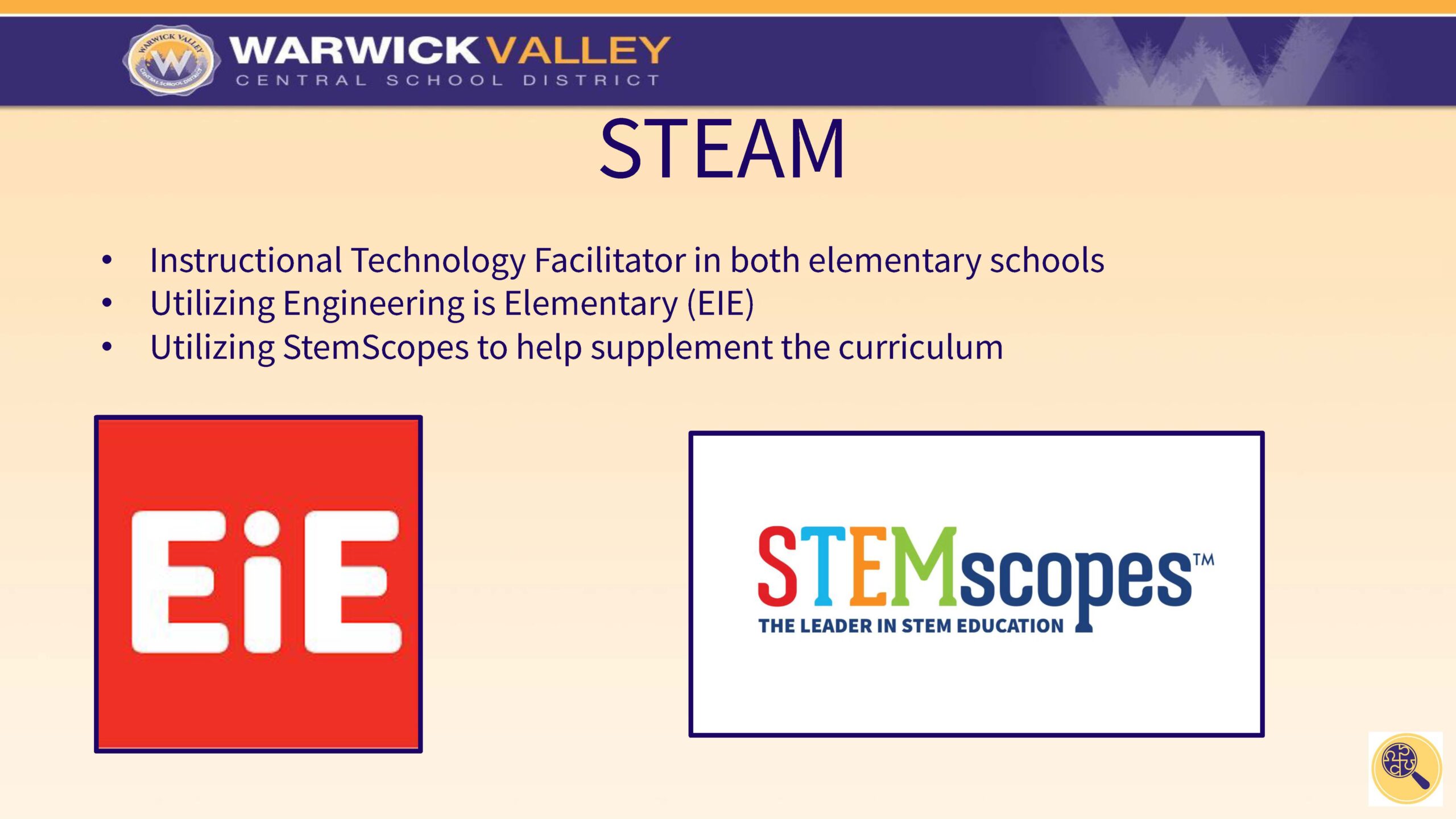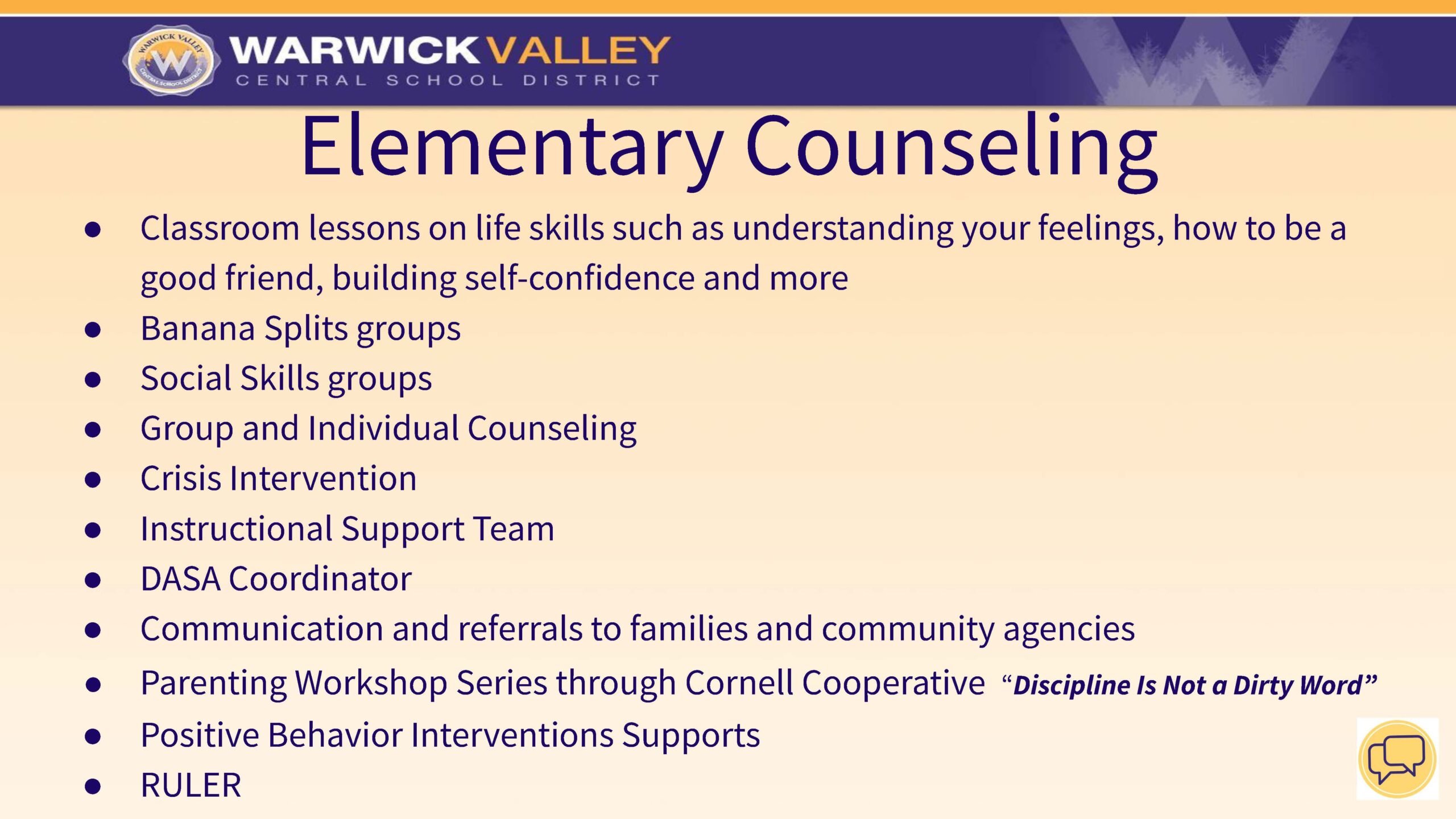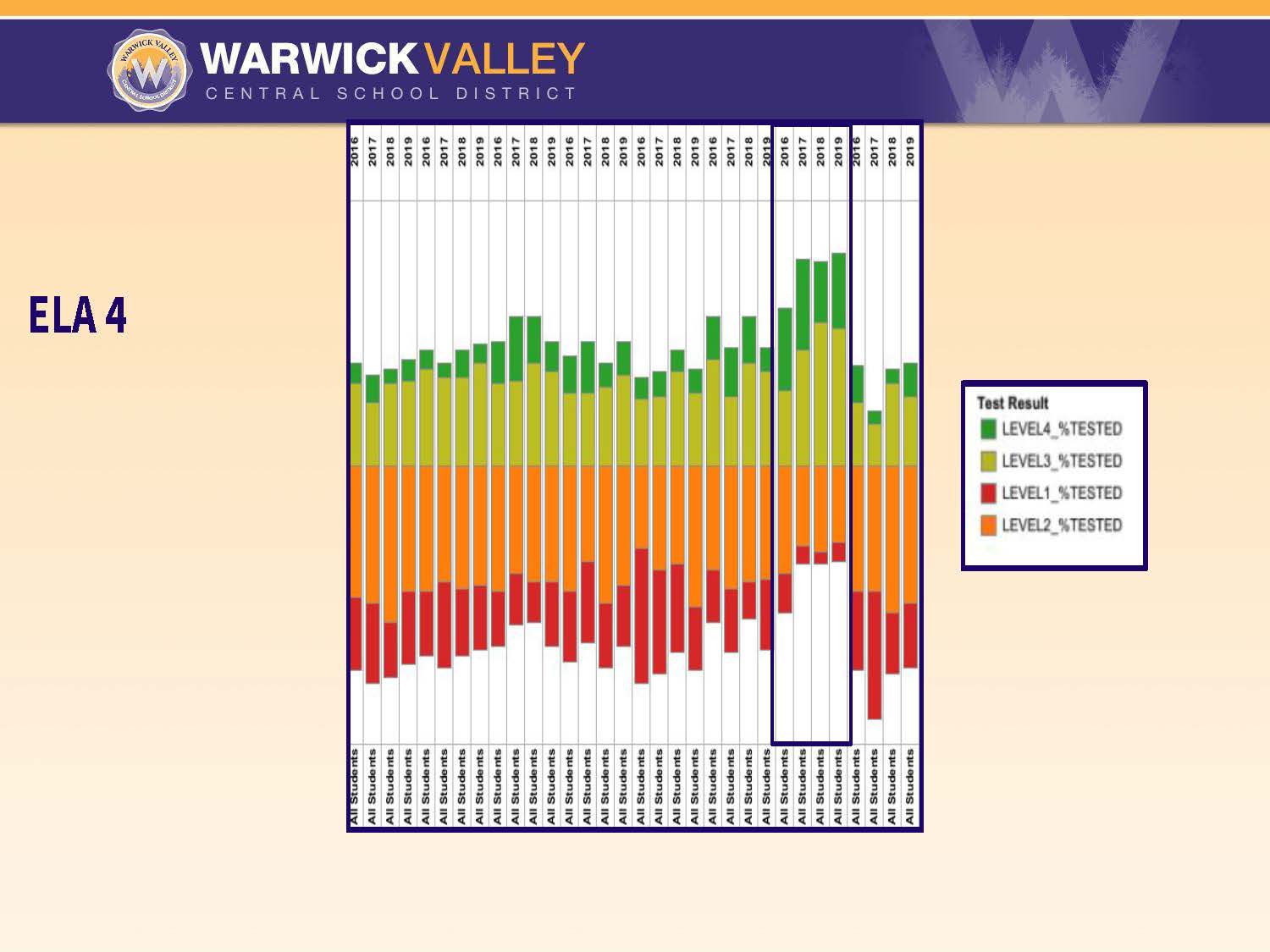“The Warwick Valley CSD Portrait of a Graduate encapsulates our collective view of the skills, qualities, and dispositions that a graduate should have to succeed in today’s global society. Significant stakeholder and community input influenced these objectives a few years ago. To that end, we must provide a coherent, engaging curriculum rich in opportunities that will prepare children for the future, not the past. Of course, quality instruction is critical, but even the most successful pedagogy won’t make up for a disconnected curriculum.” (Dr. David Leach, Superintendent of Schools)
To ensure that all students reach the Portrait of a Graduate outcomes, the district combines these facets of effective teaching and learning at the elementary school level: Engaging, coherent curriculum; hands-on, experiential learning; authentic, balanced assessment; and a culture for learning.
The Elementary Program at Warwick Valley School District
Scroll through these slides for additional detail about the WVCSD Elementary Program.
You may also view and/or download the presentation as a PDF using the link below.
View/download the presentation here.
Literacy
The mainstay of our district’s literacy program is the Reader’s & Writer’s Workshop model from Teachers College (Columbia University). It is grounded in “cognitive apprenticeship,” where there is a gradual release of responsibility related to instruction from dependence on the teacher to independence of the student.
“Cognitive apprenticeship is how we approach these workshops. A teacher is giving direct instruction, they are modeling, sharing expectations and what a final product should look like. The apprentice — the student — is observing, practicing; they’re given the tools they need to work, and the teacher provides feedback and support. This is the idea of gradual release: I do (teacher). We do (teacher and student). You do (student). It is a process that really helps foster independence, which is an essential feature of our model.” (Ms. Alisa Kadus, Literacy Coach)
Warwick Valley’s balanced approach to literacy includes components of Reader’s Workshop:
- Independent reading
- Read alouds
- Shared reading
- Word work
- Small group instruction, including guided reading, small group shared reading, and strategy lessons
The district also meets a need to supplement the Reader’s Workshops with the implementation of word study, which has begun over the last few years. Word study instruction, involves:
- Direct, explicit, and systematic instruction in phonics, phonological awareness, vocabulary, and spelling
- Synthetic (sound-based) and analytic (word-level analysis in addition to sounds) approaches to reading and writing words
- Independent and collaborative practice
In Writer’s Workshop, students:
- Learn they have stories worth telling, information worth sharing, and they can use their writing to persuade others and affect change
- Self-select their topics, leading to independence
- Write for extended periods of time, leading to increased stamina
- Collaborate with peers for feedback and assistance
- Participate in mini-lessons where the teacher offers instruction on a writing strategy or technique to try
Integrated Curriculum
We use integration to provide connections across subject areas. By relating these areas and emphasizing unifying concepts, students are better able to make connections and engage in relevant, meaningful activities that can be connected to real life. Integration can help students develop a deeper understanding of content, while accommodating a variety of learning styles, theories, and multiple intelligences.
“One example of an integrated unit we teach in fourth grade is having students read about the American Revolution. They choose the topic that interests them most, they get to collaborate with their peers, discuss their research, and ultimately present their knowledge and their expertise to their classmates. The part they really love is putting themselves in the shoes of someone who lived during the time of the American Revolution.” (Stacy Fitzgerald, elementary teacher)
STEAM
The district integrates science, engineering and mathematics into its elementary program, where students are introduced to the Engineering Design Process: Ask. Imagine. Plan. Create. Improve. Two powerful platforms are used: Engineering is Elementary (EIE) and STEMScopes. Together, EIE and STEMscopes equip Warwick Valley teachers with STEAM curricula, professional learning opportunities, and materials needed to implement real-world learning.
“We’re very proud to have an engineering design process that has been in place now for a few years, from our kindergarten classrooms all the way up to the high school. The process is: Ask. Imagine. Plan. Create. Improve. We’ve put a lot of focus on our elementary program over the past six or seven years, to really have an integrated approach to science, technology, engineering, arts, and math, and we have approached that through the lens of engineering.” (Mr. Vasilios Biniaris, Park Ave Principal)
Our STEAM program is supported by an instructional technology facilitator in both elementary schools.
Instructional Technology
Technology-rich experiences are important in preparing students for success. The district equips its classrooms with the latest learning technology, as well as experts to properly support and maintain its use. The district-wide network of computers and educational technology allows teachers to integrate technology into the curriculum and instruction.
Math
The district approach to math emphasizes the importance of establishing conceptual understanding, and reinforces that understanding with procedural practice. In grades K-8, the district is now aligned to the same chief instructional resource. Through professional development and this resource, the district expects to foster a stronger number sense in students and provide text rich lessons. The district’s elementary math curriculum focuses on learning environment, reasoning and sense-making, focus and coherence, and formative assessment.
“Students have access to an approach that establishes a really good sense of numbers and how they work. Balancing the conceptual side of learning with its formal and procedural aspects is very important. We want them to get to the place where they can manipulate the symbolism and the algorithms and, more importantly, understand what they all mean. So, making sense of the problems and reasoning are critical in our approach.” (Mr. Biniaris)
Partners in Education (PIE)
All Warwick Valley students are eligible to participate in the Partners in Education Program (PIE). The four cornerstones of the district’s PIE program are that it is a multi-age approach, provides integrated curriculum, encourages parent involvement, and fosters nature appreciation. Classroom configurations for PIE are Kindergarten; first and second grades; and third and fourth grades. PIE utilizes its faculty for collaborative design of integrated curriculum. We also offer a multi-age math resource that reflects the goals of PIE.
Response to Intervention
Warwick Valley applies a three-tiered support model called Response to Intervention (RTI) to identify and assist struggling students. The three tiers are core classroom instruction, followed by targeted small group instruction, and then intensive individual intervention. A multi-disciplinary instructional support team supports teachers as they maximize individual student success in the classroom.
“Members of our team include the building Principal, school psychologist — and maybe the counselor — the IT Facilitator, the concerned student’s general education teacher, the reading specialist, and the speech and language therapist. If needed, we will ask an occupational therapist to join. Our purpose is to support the teacher and pinpoint what’s best required to meet the needs of a particular student who may be struggling.” (Johanna Fischer, elementary SE education evaluator)
Their five-step process includes initial consultation, an instructional support team meeting, carrying out agreed-upon interventions, a follow-up meeting to assess progress, and determination of next steps.
Elementary Counseling
School counseling programs play a positive role in a student’s academic development, college and career readiness, and social and emotional development. Elementary school counselors at the district work collaboratively with administrators, classroom teachers, school staff, and families. Elementary counselors offer lessons on life skills, such as understanding one’s feelings, how to be a good friend, and building self-confidence. They also provide group and individual counseling, crisis intervention, communication and referrals to families and community agencies, positive behavior intervention supports, and more. Counselors also help coordinate the Parenting Workshop Series through Cornell Cooperative Extension.
Report Cards
The district utilizes a report card that assesses the skills that promote learning. Formerly, report cards were based on a mastery of skills. The current standards-based report cards are aligned to learning standards, and are an excellent way to report a student’s progress. Along with entries in subject areas like reading, writing, math, science, the report cards also look at skills and behaviors that promote learning, such as critical thinking, collaboration, communication, creativity, working independently, personal responsibility and time management, among them.
“We organized a report card group that worked collaboratively between grade levels to look at evolving our report card model from being focused solely on skills, to aligning with standards. We moved to a standards-based model, which clearly assesses if a child is exceeding the standards, or meeting the standards. They may be approaching the standards, and they just may not be quite there yet. Of course, we continue to evaluate and improve the model.” (Ms. Johnna Maraia, Sanfordville Principal)



